第十一讲 纵向一体化的战略分析
纵向一体化战略名词解释
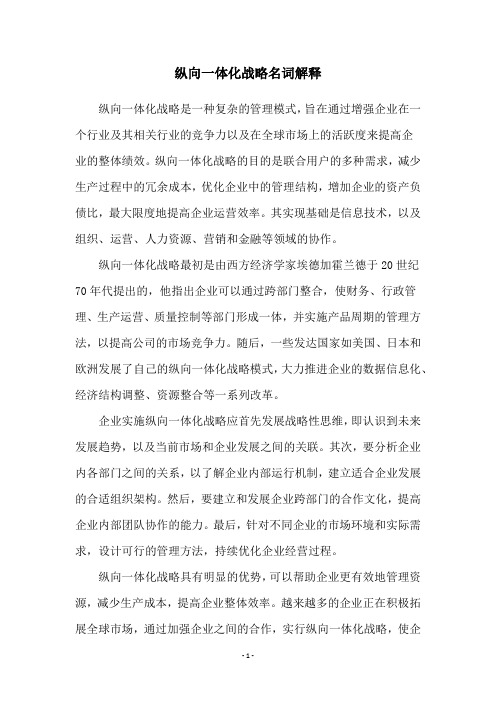
纵向一体化战略名词解释纵向一体化战略是一种复杂的管理模式,旨在通过增强企业在一个行业及其相关行业的竞争力以及在全球市场上的活跃度来提高企业的整体绩效。
纵向一体化战略的目的是联合用户的多种需求,减少生产过程中的冗余成本,优化企业中的管理结构,增加企业的资产负债比,最大限度地提高企业运营效率。
其实现基础是信息技术,以及组织、运营、人力资源、营销和金融等领域的协作。
纵向一体化战略最初是由西方经济学家埃德加霍兰德于20世纪70年代提出的,他指出企业可以通过跨部门整合,使财务、行政管理、生产运营、质量控制等部门形成一体,并实施产品周期的管理方法,以提高公司的市场竞争力。
随后,一些发达国家如美国、日本和欧洲发展了自己的纵向一体化战略模式,大力推进企业的数据信息化、经济结构调整、资源整合等一系列改革。
企业实施纵向一体化战略应首先发展战略性思维,即认识到未来发展趋势,以及当前市场和企业发展之间的关联。
其次,要分析企业内各部门之间的关系,以了解企业内部运行机制,建立适合企业发展的合适组织架构。
然后,要建立和发展企业跨部门的合作文化,提高企业内部团队协作的能力。
最后,针对不同企业的市场环境和实际需求,设计可行的管理方法,持续优化企业经营过程。
纵向一体化战略具有明显的优势,可以帮助企业更有效地管理资源,减少生产成本,提高企业整体效率。
越来越多的企业正在积极拓展全球市场,通过加强企业之间的合作,实行纵向一体化战略,使企业发挥出更大的效益,实现长久稳定的发展。
纵向一体化战略不仅能综合利用资源、提高生产效率,而且能有效地改善企业的经营管理,实现经济效益的最大化。
纵向一体化的实施不仅需要企业高管的高度关注和规划,也需要广大员工的积极参与,能够持续地发挥出最大效果。
纵向一体化战略是企业实现发展的关键,企业实施有效的纵向一体化战略是实现企业可持续发展的关键。
企业纵向一体化战略分析
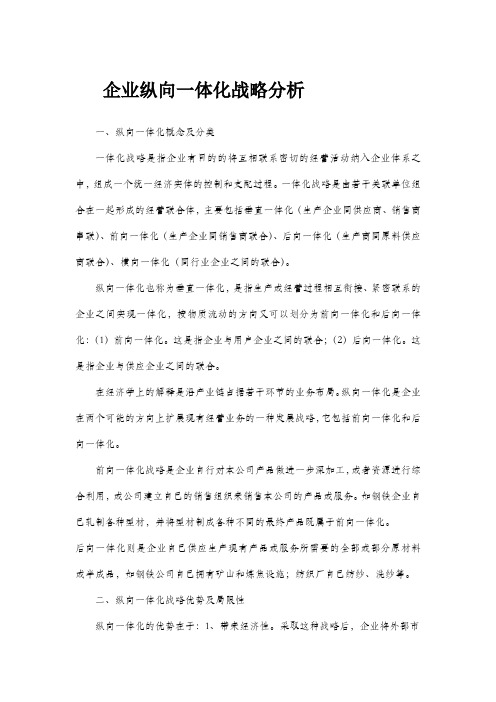
企业纵向一体化战略分析一、纵向一体化概念及分类一体化战略是指企业有目的的将互相联系密切的经营活动纳入企业体系之中,组成一个统一经济实体的控制和支配过程。
一体化战略是由若干关联单位组合在一起形成的经营联合体,主要包括垂直一体化(生产企业同供应商、销售商串联)、前向一体化(生产企业同销售商联合)、后向一体化(生产商同原料供应商联合)、横向一体化(同行业企业之间的联合)。
纵向一体化也称为垂直一体化,是指生产或经营过程相互衔接、紧密联系的企业之间实现一体化,按物质流动的方向又可以划分为前向一体化和后向一体化:(1)前向一体化。
这是指企业与用户企业之间的联合;(2)后向一体化。
这是指企业与供应企业之间的联合。
在经济学上的解释是沿产业链占据若干环节的业务布局。
纵向一体化是企业在两个可能的方向上扩展现有经营业务的一种发展战略,它包括前向一体化和后向一体化。
前向一体化战略是企业自行对本公司产品做进一步深加工,或者资源进行综合利用,或公司建立自己的销售组织来销售本公司的产品或服务。
如钢铁企业自己轧制各种型材,并将型材制成各种不同的最终产品既属于前向一体化。
后向一体化则是企业自己供应生产现有产品或服务所需要的全部或部分原材料或半成品,如钢铁公司自己拥有矿山和炼焦设施;纺织厂自己纺纱、洗纱等。
二、纵向一体化战略优势及局限性纵向一体化的优势在于:1、带来经济性。
采取这种战略后,企业将外部市场活动内部化有如下经济性,内部控制和协调的经济性;信息的经济性;(信息的获得很关键)节约交易成本的经济性;稳定关系的经济性。
2 、有助于开拓技术。
在某些情况下,纵向一体化提供了进一步熟悉上游或下游经营相关技术的机会。
这种技术信息的对基础经营技术的开拓与发展非常重要。
如许多领域内的零部件制造企业发展前向一体化体系。
就可以了解零部件是如何进行装配的技术信息。
3、确保供给和需求。
纵向一体化能够确保企业在产品供应紧缺时得到充足的供应,或在总需求很低时能有一个畅通的产品输出渠道。
纵向一体化战略

纵向一体化战略纵向一体化战略(Vertical integration strategy)目录[隐藏]1 纵向一体化战略概述2 纵向一体化的优势3 纵向一体化战略的局限性4 纵向一体化战略应用分析4.1 案例一:雅戈尔纵向一体化战略驱动力分析[1]5 参考文献[编辑]纵向一体化战略概述经济学上,沿产业链占据若干环节的业务布局叫做纵向一体化。
纵向一体化是一个战略性的计划,它是组织核心能力在企业内部扩张的一种形式,与它相同的还有横向一体化战略和加强型战略。
纵向一体化又叫垂直一体化,指企业将生产与原料供应,或者生产与产品销售联合在一起的战略形式,是企业在两个可能的方向上扩展现有经营业务的一种发展战略,是将公司的经营活动向后扩展到原材料供应或向前扩展到销售终端的一种战略体系。
包括后向一体化战略和前向一体化战略,也就是将经营领域向深度发展的战略。
前向一体化战略是企业自行对本公司产品做进一步深加工,或者资源进行综合利用,或公司建立自己的销售组织来销售本公司的产品或服务。
如钢铁企业自己轧制各种型材,并将型材制成各种不同的最终产品既属于前向一后向一体化则是企业自己供应生产现有产品或服务所需要的全部或部分原材料或半成品,如钢铁公司自己拥有矿山和炼焦设施;纺织厂自己纺纱、洗纱等。
纵向一体化的目的:是为加强核心企业对原材料供应、产品制造、分销和销售全过程的控制,使企业能在市场竞争中掌握主动,从而达到增加各个业务活动阶段的利润。
纵向一体化是企业经常选择的战略体系,但是任何战略都不可避免存在风险和不足,纵向一体化的初衷,是希望建立起强大的规模生产能力来获得更高的回报,并通过面向销售终端的方略获得来自于市场各种信息的直接反馈,从而促进不断改进产品和降低成本,来取得竞争优势的一种方法。
但并不是所有的领域都适合纵向一体化,戴维·怀特和斯达奇在1993年出版的《斯隆管理评论》中说道:“什么东西不能进行纵向一体化,什么时候不能进行垂直一体化”。
纵向一体化战略名词解释
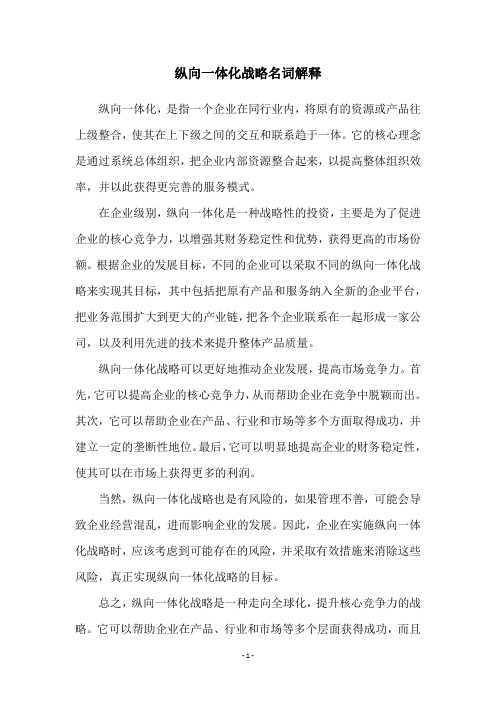
纵向一体化战略名词解释
纵向一体化,是指一个企业在同行业内,将原有的资源或产品往上级整合,使其在上下级之间的交互和联系趋于一体。
它的核心理念是通过系统总体组织,把企业内部资源整合起来,以提高整体组织效率,并以此获得更完善的服务模式。
在企业级别,纵向一体化是一种战略性的投资,主要是为了促进企业的核心竞争力,以增强其财务稳定性和优势,获得更高的市场份额。
根据企业的发展目标,不同的企业可以采取不同的纵向一体化战略来实现其目标,其中包括把原有产品和服务纳入全新的企业平台,把业务范围扩大到更大的产业链,把各个企业联系在一起形成一家公司,以及利用先进的技术来提升整体产品质量。
纵向一体化战略可以更好地推动企业发展,提高市场竞争力。
首先,它可以提高企业的核心竞争力,从而帮助企业在竞争中脱颖而出。
其次,它可以帮助企业在产品、行业和市场等多个方面取得成功,并建立一定的垄断性地位。
最后,它可以明显地提高企业的财务稳定性,使其可以在市场上获得更多的利润。
当然,纵向一体化战略也是有风险的,如果管理不善,可能会导致企业经营混乱,进而影响企业的发展。
因此,企业在实施纵向一体化战略时,应该考虑到可能存在的风险,并采取有效措施来消除这些风险,真正实现纵向一体化战略的目标。
总之,纵向一体化战略是一种走向全球化,提升核心竞争力的战略。
它可以帮助企业在产品、行业和市场等多个层面获得成功,而且
可以明显提高企业的财务稳定性,使其在竞争中取得成功。
但也要注意危险因素,并采取有效措施来解决这些风险,以实现纵向一体化战略的最终目标。
一体化战略解读课件

有在销售终端上寻求突破。”TCL总裁李东生如是说,而
市场也如是说。事情的确是发展成这样,在不掌握核心技
术的彩电业,与跨国公司相比规模不可能会是自己的优势,
企业只有在前向一体化上控制销售渠道才是明智的选择。
TCL从1992年开始建立第一个销售分公司开始致力于其前
向一体化战略部署,一体化战略的最终是TCL对销售渠道
•一体化战略解读
•5
纵向一体化的局限性
1、带来风险。纵向一体化会提高企业在行业中的投资, 提高退出壁垒,从而增加商业风险(行业低迷时该怎么 办),有时甚至还会使企业不可能将其资源调往更有价值 的地方。由于在所投资的设施耗尽以前放弃这些投资成本 很大,所以,纵向一体化的企业对新技术的采用常比非一 体化企业要慢一些。
和零售终端的控制,这种区别于其他厂商的竞争优势正是
使TCL能在彩电业脱颖而出的重要原因之一。
•一体化战略解读
•10
实施纵向一体化战略可以为企业带来成功,但并 不意味着任何一个企业都能分享到一体化的胜果。 事实往往是一体化战略将使企业产生高昂的管理 成本,一体化可以被理解为企业多元化经营的一 种,企业进入一个新的行业,在管理和协调上都 会遇到各种难以预料的困难。而TCL的成功也并非 是每个企业都可以模仿的,其销售网络的成功并 非一朝一夕之功,其相关的多元化经营使销售网 络具有的广度经济效应,从而生产的各种产品可 以为销售网络分担成本,即使是如此TCL每年的销 售网络运营费用也近十亿元。纵向一体化的成本 问题将企业战略选择推到了尴尬的位置上。不管 愿意与否,经营成本是一体化必须面对的一个问 题。
和协调由此所到来的变化。从外部购买零配件通常比自己
制造便宜一些,简单一些,使企业能够更加灵活,快捷地
纵向一体化战略

06
纵向一体化战略的未来发展
技术创新推动纵向一体化变革
自动化技术
物联网
随着自动化技术的不断发展,企业将 能够通过自动化设备实现生产流程的 智能化和高效化,提高生产效率和产 品质量。
物联网技术将实现设备与设备之间的 互联互通,提高生产过程中的协同效 应和信息传递效率。
人工智能
人工智能技术将在纵向一体化战略中 发挥越来越重要的作用,例如通过机 器学习算法优化生产流程、预测市场 需求等。
企业需要通过优化内部管理流程和组织结构,降低内部交易成本和提高运 营效率。
对市场变化的适应性降低
01
纵向一体化战略可能导致企业对市场变化的适应性降
低。
02
在一体化战略下,企业需要协调各个环节和业务领域
的运作,对市场变化的反应速度可能会变慢。
03
企业需要建立灵活的管理机制和快速响应市场变化的
机制,以提高适应性和竞争力。
数字化和智能化提升纵向一体化效率
1 2
数据驱动决策
通过收集和分析数据,企业能够更好地了解市场 需求和生产状况,从而制定更加科学和有效的决 策。
智能化生产
数字化和智能化技术能够实现生产过程的自动化 和智能化,提高生产效率和产品质量。
3
供应链管理优化
数字化和智能化技术能够实现供应链的实时监控 和优化,提高供应链的协同效应和响应速度。
环境可持续性成 境保护,推行绿色生产理念,减 少对环境的负面影响。
资源循环利用
企业将更加注重资源的循环利用 ,通过回收和再利用废弃物降低 生产成本和环境负担。
社会责任
企业将更加注重社会责任的履行 ,通过积极参与社会公益事业提 升品牌形象和社会影响力。
管理难度增加
纵向一体化的含义及类型

利用市场的收益和成本
收益(R1):市场厂商可以达到规模经济; 市场厂商受市场规则的约束,它必须是有效 率和创新性的。 成本(C1):纵向链条中生产过程的协调 可能收到损害;私有的信息可能会泄露;产 生与独立市场厂商的交易费用。
刺激企业进行纵向一体化。
在经济全球化的条件下,企业实行纵向 一体化还有一个重要原因就是通过一体化来 扩大自己的实力和影响,在全球范围内进行 竞争。由于现代科学技术的快速发展特别是 交通、通讯技术的发展,使经济竞争的主战 场逐步从国内市场转向国际市场。
二、纵向一体化的成本分析
纵向一体化是把企业之间的市场协调变为 企业内部的非市场协调,可以带来很多方面的 收益,上面已讨论,但是纵向一体化有时候又 会出现解体,说明纵向一体化对企业而言也会 产生成本,首先讨论纵向一体化对企业产生的 影响。
例,美国铝生产巨头阿尔科公司(Alcoa)
三、对进入障碍的潜在影响
如果某种产品的生产过程是高度一体化的, 试图进入该产品市场的新企业就必须在多个生产 阶段同时进入。这样的话,由于存在经营风险、 必要资本量以及需要在多个生产经营阶段同时进 入,潜在的竞争新企业就往往“望而却步”了。
四、削减了消费者剩余
后向一体化:在现有业务基础上,向上游 业务发展,即通过收买、兼并、联合等形式, 拥有或控制企业的原材料及其他供应系统, 实行“供产”一体化。
前向一体化:在现有业务基础上,向下游 业务发展,即通过收买、兼并、联合,建立 经销系统,形成“产销”一体化。
纵向一体化战略讲解ppt课件
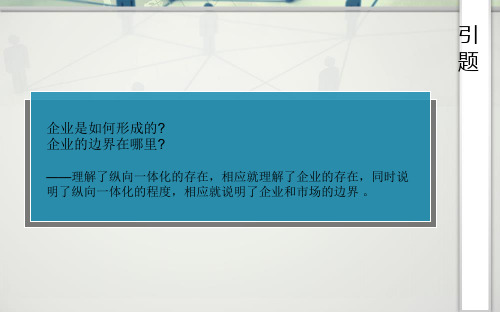
• 第一,双边垄断。双边垄断将产生高价格、低产出的结果,消费者,厂商 均遭受损失。如实现纵向一体化对双方有利。
• 第二,排挤行为与进入壁垒。如KennethClarkson(1989)等所述,在一些 情况下,一个强有力的纵向一体化企业能把未纵向一体化的企业排挤出去 (被迫“高进低出”)
• 2.2 交易费用理论对企业的认识——纵向一体化的 由来
篮球比赛是根据运动队在规定的比赛 时间里 得分多 少来决 定胜负 的,因 此,篮 球比赛 的计时 计分系 统是一 种得分 类型的 系统
2.1.1分工协作理论下企业边界的选择
• 分工和专业化是企业纵向关系形成的基础 • 古典经济学通过规模经济来解释企业扩张的机理,涉及
产业生命周期说 规避不确定说
随着产业生命周 期改变
实行纵向一体化 可以规避不确定 性
产 业 组 织 学 派
篮球比赛是根据运动队在规定的比赛 时间里 得分多 少来决 定胜负 的,因 此,篮 球比赛 的计时 计分系 统是一 种得分 类型的 系统
3.1产业组织学派的纵向一体化动因理论
• (1)垄断动机说
篮球比赛是根据运动队在规定的比赛 时间里 得分多 少来决 定胜负 的,因 此,篮 球比赛 的计时 计分系 统是一 种得分 类型的 系统
2、纵向一体化的起源——企业边界理论
• 2.1 新古典经济框架下企业边界的选择要素
• 2.1.1 分工协作理论下企业边界的选择 • 2.1.2 厂商理论下企业的边界选择——“黑箱”理论
篮球比赛是根据运动队在规定的比赛 时间里 得分多 少来决 定胜负 的,因 此,篮 球比赛 的计时 计分系 统是一 种得分 类型的 系统
横向一体化、纵向一体化、多元化发展战略区别PPT

多元化的风险
1. 实施多元化战略使企业竞争力减弱。 一个想在市场上生存和成长的企业必须具备应有的竞争力,竞争力不仅是企业长期生存的资本,也是企
业赢得成功的武器。企业多元化战略的实施,必然会分散企业的经营资源,还有可能削弱企业在原有领域的 竞争力,这种削弱不仅是资金方面的,管理层注意力的分散也是一个方面,它所带来的不良后果往往是比较严 重的。毕竟原产业是多元化经营的基础,新产业在经营初期需要原产业的支持,如果原产业这个基础产业的 竞争能力受到削弱,多元化经营必将面临危机。 2. 过分追求多元化经营容易出现决策失误。
横向一体化
定义:是指把与本企业处在生产一营销链上同一个阶段具有不同资源优势的企 业单位联合起来形成一个经济体。横向一体化的实现途径包括收购、兼并、基 于契约关系的分包经营和许可证及特许权经营、基于产权关系的合资经营等。
表现形式
1. 利用本企业外部资源快速反应市场需求,本企业只抓自己的核心竞争力的 业务,而将非核心业务委托或外包给合作伙伴。
多元化
定义:多元化战略是指企业为了更多地占领市场和开拓新市场,或避免经营单 一事业的风险而选择性地进入新的事业领域的战略。
横向一体化和纵向一体化战略的含义
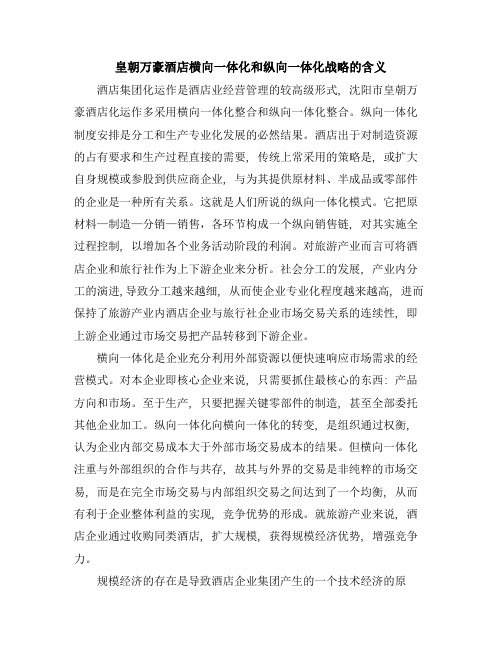
皇朝万豪酒店横向一体化和纵向一体化战略的含义酒店集团化运作是酒店业经营管理的较高级形式, 沈阳市皇朝万豪酒店化运作多采用横向一体化整合和纵向一体化整合。
纵向一体化制度安排是分工和生产专业化发展的必然结果。
酒店出于对制造资源的占有要求和生产过程直接的需要, 传统上常采用的策略是, 或扩大自身规模或参股到供应商企业, 与为其提供原材料、半成品或零部件的企业是一种所有关系。
这就是人们所说的纵向一体化模式。
它把原材料—制造—分销—销售,各环节构成一个纵向销售链, 对其实施全过程控制, 以增加各个业务活动阶段的利润。
对旅游产业而言可将酒店企业和旅行社作为上下游企业来分析。
社会分工的发展, 产业内分工的演进,导致分工越来越细, 从而使企业专业化程度越来越高, 进而保持了旅游产业内酒店企业与旅行社企业市场交易关系的连续性, 即上游企业通过市场交易把产品转移到下游企业。
横向一体化是企业充分利用外部资源以便快速响应市场需求的经营模式。
对本企业即核心企业来说, 只需要抓住最核心的东西: 产品方向和市场。
至于生产, 只要把握关键零部件的制造, 甚至全部委托其他企业加工。
纵向一体化向横向一体化的转变, 是组织通过权衡, 认为企业内部交易成本大于外部市场交易成本的结果。
但横向一体化注重与外部组织的合作与共存, 故其与外界的交易是非纯粹的市场交易, 而是在完全市场交易与内部组织交易之间达到了一个均衡, 从而有利于企业整体利益的实现, 竞争优势的形成。
就旅游产业来说, 酒店企业通过收购同类酒店, 扩大规模, 获得规模经济优势, 增强竞争力。
规模经济的存在是导致酒店企业集团产生的一个技术经济的原因。
酒店企业计划成本是企业规模的函数, 当酒店企业规模合理时, 酒店的内部计划成本所产生的经济效益明显地显示出来, 酒店获得了规模效益。
随着大量生产过程中的标准化而带来的生产准备费用的节约, 也会导致单位产品的变动成本绝对值下降。
采用横向一体化战略,企业可以有效地实现规模经济,快速获得互补性的资源和能力。
航空集团纵向一体化的发展战略

航空集团纵向一体化的发展战略王志文摘要:本文总结纵向一体化战略的内涵、形式和相关经济学解释,研究航空企业集团发展战略的基本对策,最后讨论了后向一体化(开展飞机维修业务)和前向一体化(开展航空旅游相关业务)的实践经验。
关键词:航空企业集团纵向一体化战略飞机维修航空旅游一、纵向一体化战略的内涵、形式与经济学解释纵向一体化是指在某一企业范围内把技术上不同的生产、分销或其它经济过程结合起来,用内部的或行政管理上的交易来代替市场交易去实现其经济目的。
在纵向生产过程中各阶段的产品,虽然互为投入与产出,但若是由不同企业制造并在市场上出售,理所当然被视为不同的产品。
同理,即使纵向一体化企业只生产一种产品,仍然把各个阶段的产品(中间品)看作不同。
纵向一体化企业实质上是多产品生产企业,只不过这些多产品在企业内部交易(通过组织内进行协调),只有最后一阶段的最终产品才到市场交易。
威廉姆森用资产专用性理论来分析纵向一体化,他认为由于某些投资只有用在某些地方才能产生最大的效用,即具有资产专用性,这种投资会弱化投资方在投资完成后的谈判地位。
由于投资方会预期到这个结果,从而会减少投资。
这样契约无法达到完全规避签约方机会主义的完备程度,从而使得纵向一体化变得必要。
纵向一体化可以防止市场交易中的机会主义,从而节约了交易费用。
麦克尔.波特指出纵向一体化具有如下的优势:(1)在合并作业、内部控制与协调、信息取得等方面存在经济性;(2)在供需上,降低了不确定性;(3)在交易上,抵消了供应商和顾客的讨价还价能力,将供应商的利润内部化为能够表明这种投入的真实成本;(4)提高其他企业的进入的壁垒;(5)可进入高回报产业,获得高的总投资回报率。
同时,纵向一体化也会带来如下的成本:(1)较高的退出壁垒,同时进入到相邻业务领域要承担的成本;(2)增加了经营杠杆,使企业面临收入上较大的周期性变化;(3)减低了改换合作伙伴的灵活性;(4)弱化了激励效应,容易导致的低效的经营行为倾向;(5)一体化后的上下游单位的不同管理要求,增加了管理费用。
南大贾定良 第11讲纵向一体化战略(英文)

6.Some Illusions in Vertical Integration Decisions
⑴A strong market position in one stage can
automatically be extended to the other
September 2002 NJU 贾良定 7
4.Particular Strategic Issues in Backward Integration
⑴PROPRIETARY KNOWLEDGE ⑵DIFFERENTIATION
September 2002
NJU 贾良定
8
5.Contracts, Tapered Integration and Quasi-Integration
第十一讲 纵向一体化的战略分析
1.Strategic Benefits of Vertical Integration 2.Strategic Costs of Vertical Integration 3.Particular Strategic Issues in Forward Integration 4.Particular Strategic Issues in Backward Integration 5.Contracts, Tapered Integration and Quasi-Integration 6.Some Illusions in Vertical Integration Decisions
september2002nju贾良定1第十一讲纵向一体化的战略分析1strategicbenefitsofverticalintegration2strategiccostsofverticalintegration3particularstrategicissuesinforwardintegration4particularstrategicissuesinbackwardintegration5contractstaperedintegrationandquasiintegration6someillusionsinverticalintegrationdecisionsseptember2002nju贾良定2?verticalintegrationisthecombinationoftechnologicallydistinctproductiondistributionsellingandorothereconomicproces
纵向一体化战略的实施步骤

纵向一体化战略的实施步骤引言纵向一体化战略是指企业在供应链上不断整合资源和合作伙伴,实现供应链上下游的紧密协作,以提供更高质量的产品和服务。
在当前竞争激烈的市场环境中,纵向一体化战略已经成为企业提升核心竞争力的重要手段。
本文将介绍纵向一体化战略的实施步骤,以帮助企业更好地实施这一战略。
步骤一:战略规划一项成功的纵向一体化战略需要有清晰的战略规划。
在这一步骤中,企业需要明确目标和战略路线,包括确定纵向合作伙伴、整合资源和优化供应链。
具体步骤包括:•明确战略目标:确定实施纵向一体化战略的目标,例如提高产品质量、降低成本、增加客户满意度等。
•分析供应链:了解供应链上下游的关系,并确定在哪些环节可以进行纵向整合。
•选择合作伙伴:研究市场上的合作伙伴,选择与企业战略相契合的合作伙伴。
•整合资源:整合企业内部的资源,包括人力、财力、技术等,为纵向一体化做好准备。
步骤二:信息共享与协调纵向一体化战略的关键在于信息共享和协调。
在这一步骤中,企业需要建立起有效的供应链信息系统,并与合作伙伴建立紧密联系,以实现信息共享和协调。
具体步骤包括:•建立供应链信息系统:企业需要投资建立先进的供应链信息系统,以便实现供应链中各个环节的信息共享和实时监控。
•制定信息共享规则:与合作伙伴共同制定信息共享的规则和流程,确保信息的及时传递和准确性。
•协调供应链活动:确定供应链上各个环节的责任与权力,协调供应链活动,避免出现矛盾和阻碍。
步骤三:整合供应链纵向一体化战略要求企业与合作伙伴之间形成紧密的合作关系,共同打造高效的供应链。
在这一步骤中,企业需要整合供应链中的资源和能力,以提供高质量的产品和服务。
具体步骤包括:•加强合作伙伴关系:与合作伙伴建立长期稳定的合作关系,建立信任和互利共赢的合作模式。
•共同研发与创新:与合作伙伴合作进行新产品研发和创新,共同推动供应链的升级和发展。
•优化供应链流程:对供应链流程进行优化,减少不必要的环节和浪费,提高效率和灵活性。
战略管理——纵向一体化与多角化战略

资源外取战略的决策依据
成本
经营环境
资源外 取决策
技术
供应商
战略管理——纵向一体化与多角化战 略
J.B.Quinn(1990)等人提出的 资源外取的七个战略性问题
• 我们是否真想长期地在企业内部制造某项产品或服务? 如果想的话,我们是否愿意进行必要的投资以保持一种领 先的地位? 这对保护我们的核心能力是否致关重要?
• 如果不能,——
• 我们能建立起控制和刺激,以使总的交易成本低于在企业内
部生产时的成本吗?
战略管理——纵向一体化与多角化战 略
资源外取方式
高
完全所有权;
部分所有权;
对 控
联合开发;
制 性
预先保留;
的 需
长期合同;
要
买入期权;
低 短期合同。
高
对灵活性的需要
低 战略管理——纵向一体化与多角化战 略
第三节 多角化战略
因素将会引起大量高风险、高费用的争价行为。
战略管理——纵向一体化与多角化战 略
交易的形态(Macneil的划分)
• 古典契约法--强调法规和正式文件。 • 新古典契约法--着重统制机制设计与争议处置效益,如
中介人、仲裁者。因为对於长期性且不确定性高之交 易,无法完整预知各项情境,明订於契约,因之必需 引用统制机制,设计於契约中,以便顺应日後各项情 境发生之处理依据,甚或引起交易争议时,能顺利解 决纷争。(统制机制: 市场规制) • 关系式契约: 属於期限既长且复杂之交易。 其重点是 长期性随时间与情境变异而有不同之交易基准,此种 契约方式需能调适此项变异,以维系最初交易初衷, 或顺应调整交易条件。(例如: 技术引进)
垂直一体化战略介绍

采用这种战略,是为获得原有成品深加工的高附加价值。一般 是把相关的前向企业合并起来,组成统一的经济联合体。这通 常是制造商的战略。
当一个企业发现它的价值链上的 前面环节对它的生存和发展至关重要时, 它就会加强前向环节的控制。
Page28
实施前向一体化的一种有效方式是特许经营,采用特许经营 的形式授权其他厂商经销自己的产品并提供售后服务,是用 途最广、也是非常有效的前向一体化方式。
Page23
五、垂直一体化战略
是一个企业沿着某种产品或服务的价值链的前后方向进行延
伸和扩展是将公司的经营活动向后扩展到原材料供应或向前
扩展到销售终端的一种战略体系。
所以当一个企业所从事的价值链中的阶段数越多,其纵向一 体化程度就越高。反之,则纵向一体化程度越低。
逆方向
顺方向
图5.1
Page24
没有战略的企业就像没有舵的船一样只会在原地转圈, 又像个流浪汉一样无家可归。 乔尔·罗斯和迈
克尔·卡米
Page4
一、引言及相关概念
我们大家都知道,某种产品的生产,往往 只取从原材料生产到最终产品销售整个 系统中的一个阶段,而每个阶段都有其 完整的生产体系。
对任何厂商来说,一个基本问题就是 确定产业链条中哪些活动应该自己完成, 哪些活动应该交给市场上的独立厂商去 完成,这类问题被称为“生产或采购”问题。
入和产出的两个厂商之间发生的时候,这种兼并就是纵向一体 化。……关于纵向一体化的一般定义,简单来说就是这样一种 厂商的行为,这种厂商在某一产品生产过程中占有诸多不同的 连续阶段。” 科斯(1937)认为“当先前由两个或多个企业家组织交易变成一 个企业家组织时,便出现了联合。当所涉及的先前由企业家之 间在市场上完成的交易被组织起来时,这便是一体化”。 格罗斯曼和哈特(1996)从资产所有权角度将纵向一体化定义为 “纵向一体化是购入某一供给者(或购买者)的资产,其目的在 于获得剩余控制权”。
(战略管理)纵向一体化及其利弊分析

前向一体化:对本公司产品进一步加工,或对 资源进行综合利用或公司建立自己的销售组织 来销售本公司产品或服务的战略。
后向一体化:企业自己供应生产现有产品或服 务所需要的全部或部分原材料或半成品。
纵向一体化战略的利益
若纵向一体化产生很大的规模经济或资本需求壁垒,则会 增加产业中的移动壁垒。
5.进入高回报产业
6.防止被封阻
若竞争者们是纵向一体化的企业,那么一体化就具有防 御意义。竞争者的广泛一体化能够占用许多供应资源或者拥有 许多称心的顾客和零售机会,若企业不选择一体化,则可能被 封阻。
2. 开拓技术 提供进一步熟悉上游ห้องสมุดไป่ตู้下游事业相关技术
的机会,对基础事业的开拓与发展非常重要。
3.确保供给和需求 确保企业在产品供应紧缺时得到充足的供应, 或在总需求很低时能有一个产品输出渠道。务。
4.提高进入和移动壁垒。
通过纵向一体化可得到某些战略优势,如较高的价格,较 低的成本或较小的风险,从而提高了产业的进入壁垒。
- 1、下载文档前请自行甄别文档内容的完整性,平台不提供额外的编辑、内容补充、找答案等附加服务。
- 2、"仅部分预览"的文档,不可在线预览部分如存在完整性等问题,可反馈申请退款(可完整预览的文档不适用该条件!)。
- 3、如文档侵犯您的权益,请联系客服反馈,我们会尽快为您处理(人工客服工作时间:9:00-18:30)。
INTEGRATION – It is essential to recognize the possibility that some
economies of integration could be gained by the right type of long-term or even short-term contract between independent firms.
13
⑷Vertical integration can serve a strategically
sick business
– Each stage of a vertical chain must be strategically sound to insure the health of the enterprise as a whole. If one link is sick, the sickness is more likely to spread to the other healthy units.
PARTNERS
⑷HIGHER OVERALL EXIT BARRIERS
5
⑸CAPITAL INVESTMENT REQUIREMENTS ⑹FORECLOSURE OF ACCESS TO
SUPPLIER OR CONSUMER RESEACH AND /OR KNOW-HOW
⑺MAITAINING BALANCE ⑻DULLED INCENTIVEቤተ መጻሕፍቲ ባይዱ ⑼DIFFERING MANAGERIAL
第十一讲 纵向一体化的战略分析
1.Strategic Benefits of Vertical Integration 2.Strategic Costs of Vertical Integration 3.Particular Strategic Issues in Forward Integration 4.Particular Strategic Issues in Backward Integration 5.Contracts, Tapered Integration and Quasi-Integration 6.Some Illusions in Vertical Integration Decisions
BARRIERS
⑺ENTER A HIGHER RETURN BUSINESS ⑻DEFEND AGAINST FORECLOSURE
4
2.Strategic Costs of Vertical Integration
⑴COST OF OVERCOMING MOBILITY
BARRIERS
⑵INCREASED OPERATING LEVERAGE ⑶REDUCED FLEXIBILITY TO CHANGE
10
⑶QUASI-INTEGRATION
– Quasi-integration is the establishment of a relationship between vertically related businesses that is somewhere in between longterm contracts and full ownership.
integration.
②The degree of taper(the proportion of product or service purchased
outside) can be adjusted to reflect the degree of risk in the market.
③Taper can also be used to guard against imbalance between stages. ④Tapered integration reduces the risk of locked-in relationships to
REQUIREMENTS
6
3.Particular Strategic Issues in Forward Integration
⑴IMPROVED ABILITY TO
DIFFERENTIATE
⑵ACCESS TO DISTRIBUTION CHANNELS ⑶BETTER ACCESS TO MARKET
2
1.Strategic Benefits of Vertical Integration
⑴ECONOMIES OF INTEGRATION
– ①Economies of Combined Operations. – ②Economies of Internal Control and Coordination – ③Economies of Information. – ④Economies of Avoiding the market. – ⑤Economies of Stable Relationships.
INFORMATION
⑷HIGHER PRICE REALIZATION
7
4.Particular Strategic Issues in Backward Integration
⑴PROPRIETARY KNOWLEDGE ⑵DIFFERENTIATION
8
5.Contracts, Tapered Integration and Quasi-Integration
⑵TAPERED INTEGRATION
– Tapered integration is partial integration backward or forward, the firm purchasing the rest of its needs on the open market.
9
Advantages: ①Tapered integration results in less elevation in fixed costs than full
the extent of the degree of taper.
⑤It also gives the firm some access to outside R&D activities and can
provide a partial solution to the problem of internal incentives.
11
6.Some Illusions in Vertical Integration Decisions
⑴A strong market position in one stage can
automatically be extended to the other
– Only if the integration per se produced some tangible benefits would integration allow the extension of market power, because under these circumstances it would improve the competitiveness of the combined entity.
⑵TAP INTO TECHNOLOGY ⑶ASSURE SUPPLY AND /OR DEMAND
3
⑷OFFSET BARGAINING POWER AND
INPUT COST DISTORTIONS
⑸ENHANCED ABILITY TO
DIFFERENTIATE
⑹ELEVATE ENTRY AND MOBILITY
⑥Tapered integration allows the firm to prove that a threat of full
integration is credible, which provides a strong discipline on suppliers or customers and may avoid the necessity of full integration to offset bargaining power.
• In theory, all the functions we now expect a corporation to perform could be performed by a consortium of independent economic entities, each contracting with a central coordinator, which itself need be little more than a desk and a single manager.
1
• Vertical integration is the combination of technologically distinct production, distribution, selling, and/or other economic processes within the confines of a single firm. As such, it represents a decision by the firm to utilize internal or administrative transactions rather than market transactions to accomplish its economic purposes.
– minority equity investment; – loans or loan guarantees; – prepurchase credits; – exclusive dealing agreements; – specialized logistical facilities; – cooperative R&D.
